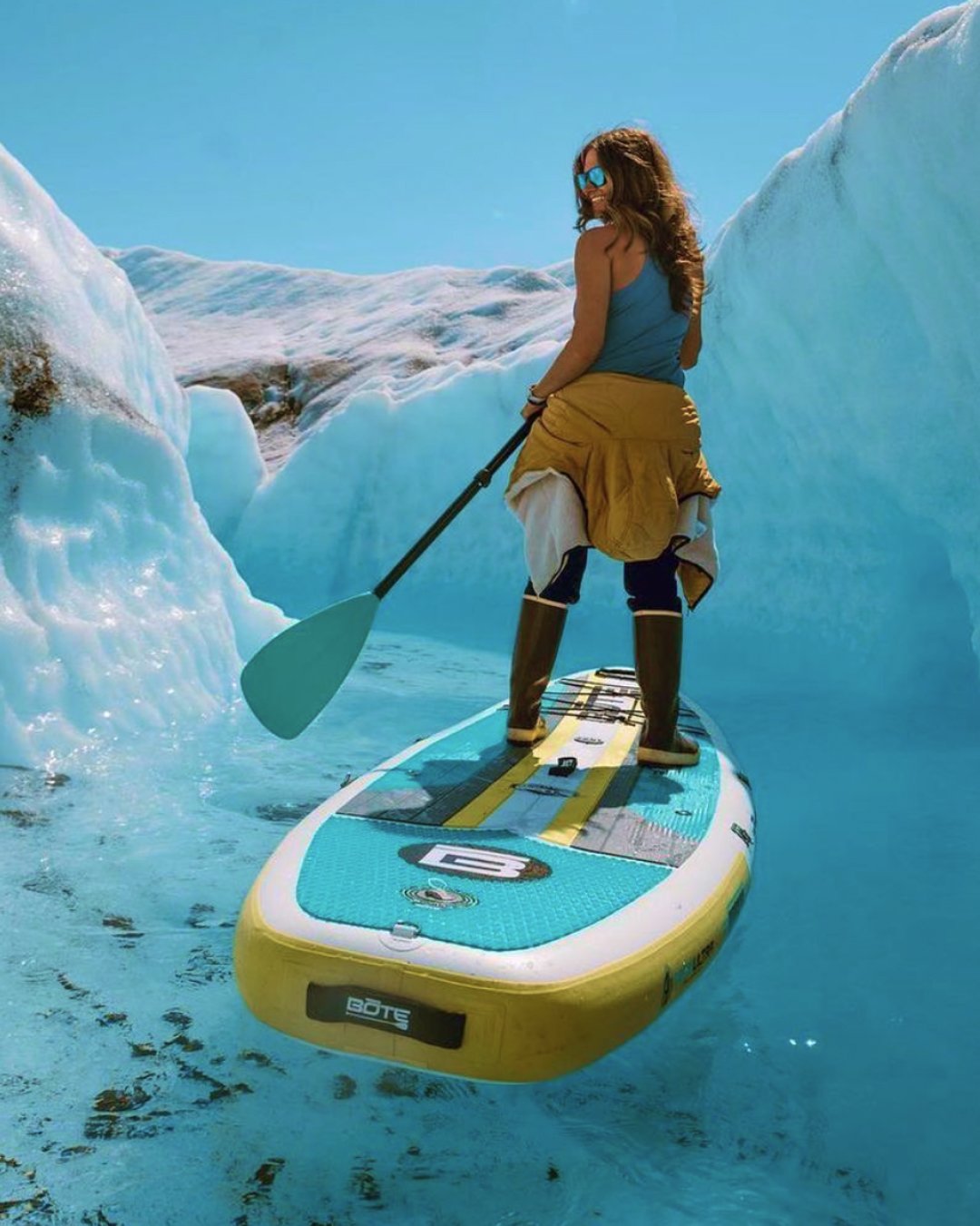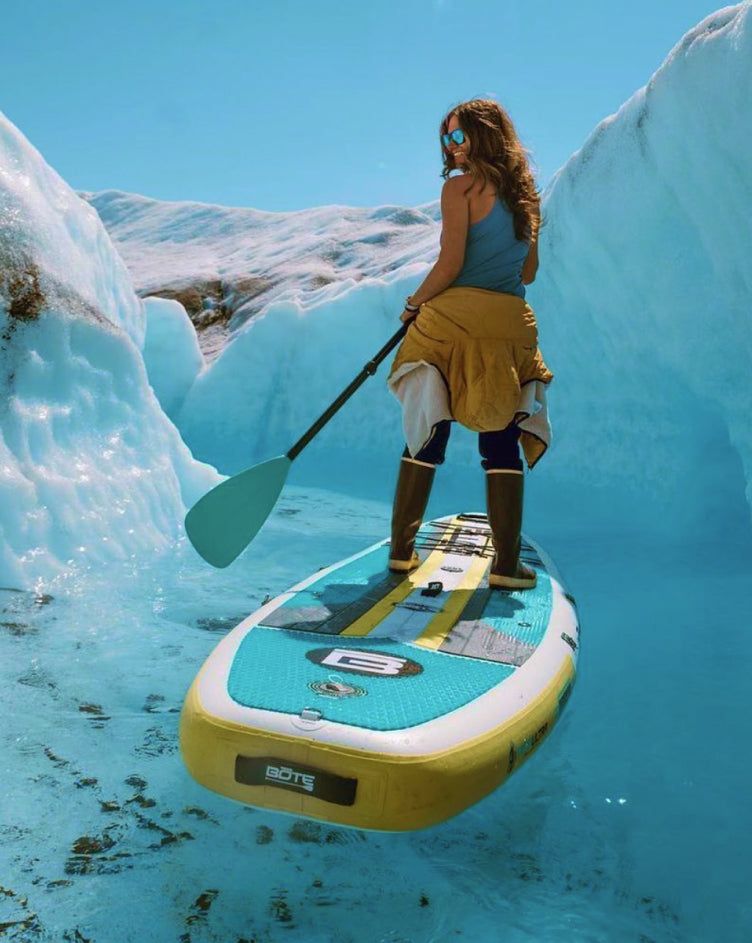SUP Yoga For Beginners
There are few water vessels more versatile and mobile than a stand up paddle board. You can reach waters less traveled for an adventurous afternoon, connect with pals and four-legged friends while casting a line, and get a killer workout while paddling against a current. But have you considered throwing SUP yoga into the mix?
At first glance, the terms ‘SUP’ and ‘yoga’ may not seem like a match made in the waterways, but you’d be surprised to learn that getting your flow on outside of the studio and on the water is a hell of a lot more fun. SUP yoga combines classic yoga poses to center your mind and body with the ability to do it in the most peaceful of places thanks to your SUP.

Why SUP Yoga?
Whether you’re a land-loving yogi or a born and raised water baby, SUP yoga brings a new opportunity to connect your inner self with your outer surroundings. “It’s one size fits all when you tailor it to yourself,” says Erin O’Malley, owner of Sunset Stand Up Paddle, pureblood adventurer, and BOTE ambassador. O’Malley believes the best part of SUP yoga is realizing that imperfection is beauty, and what she means by that is… you’re probably gonna fall off your board.
It’s okay though, falling off the paddle mid-tree pose is half the fun.
“It’s one size fits all when you tailor it to yourself” – Erin O'Malley
Benefits of SUP Yoga
- It’s super fun—plain and simple. You can’t help but laugh when you find yourself a little unstable in positions you’d often be rooted in on land. A once simple yoga pose, like a cat/cow rotation, is now a wobbly mess. But that’s one of the main benefits of SUP yoga; it takes the seriousness out of your stances and reminds you to enjoy it. That’s something you won’t get on land.
- It provides a bit of a challenge. Whether you’re using a traditional stand up paddle board like our Flood Aero, or a floating yoga platform like the Inflatable Dock FX, the buoyant platform is going to dare you to really dig into your poses. The instability of a floating platform not in motion adds a new element to your flow. You’ll learn to push through by focusing harder on your weight distribution, breathing pattern, and transitions.


- The environment is second to none. How else can you practice relaxation and meditation wherever you damn well please? The portability of your SUP, specifically an inflatable SUP, gets you out into the elements so you can incorporate nature into your yoga practice. Want to do it in a remote part of a crystal clear lake? You got it. How about at dawn when the ocean is smooth as glass? Easy enough. Just throw your Aero Bag over your shoulder, travel to your preferred zen location, unroll, inflate, and meditate.

Preparing For SUP Yoga
Preparing for a SUP yoga class is pretty easy. Swap out the yoga mat for a paddle board or dock, grab the same essentials (like water and a towel), and you’re set for a power flow like you’ve never experienced. However, just like any other outdoor activity, choosing the right gear can be the deciding factor between a fly by night, one and done SUP yoga attempt versus adding it to your fitness rotation for the long haul.
Step 1: Choose the Right SUP Board
Whether you’re a SUP voyager who already owns a stand up paddle board, or new to the SUP world and navigating how to get started, SUP yoga classes typically give the option to BYOB (bring your own board) or rent one of theirs for class. At BOTE, no two boards are created equal, but they are created to be the best performers in their category.
When choosing your board, we recommend going with an inflatable SUP or inflatable dock for its durability and portability. You want to take it to serene, untouched nature, right? Well, an inflatable let’s you do just that by rolling it up into its portable bag and hauling it on your back.
Look for a Full Trax design. Our Full Trax series allows you to grip anywhere on the board, thanks to the full length BVA foam deck pad. Paired with a flat bottom to help maintain a low center of gravity, this unique design allows you to reach maximum stability and strength as you flow through each pose.

The Full Trax Flood Aero Inflatable Paddle Board - When it comes to SUP yoga, stability is the goal, and with a full-length deck pad to give you that grip in both your hands and your feet, plus a flat bottom and entry rocker nose for added steadiness, the Full Trax Flood Aero is a great option for beginner SUP yogis who also want to indulge in the SUP lifestyle.

The Inflatable Dock 10 - If you’re looking to take your yogi status to the next level, a fitness platform, such as an Inflatable Dock, has the essentials to keep you steady during your shavasana and relaxed when you just want to kick back. The Dock 10′ is a ten foot square platform, giving you more room to work within your poses, and even enough for a friend to join. It’s slip-resistant from head to toe so you can grip firmly and confidently, no matter the stance. It’s made with our Aero Technology™, and equipped with multiple attachment points for bungee straps, grab handles, and more.
Step 2: Master the Dress Code
“Dress for your comfort and your skin type,” says O’Malley. Your comfort barometer can be anywhere from a loose tank and yoga pants to an athletic bikini. Just know that it’s likely you’ll be in the water at some point, so wear clothes you’re comfortable getting wet and that won’t rub or irritate your skin. If you’re sensitive to the sun, consider clothing that provides more coverage. Always lather up with SPF.
Basically, the dress code is no code. You do you.
Step 3: Choose Your SUP Yoga Accessories
You’ve swapped your indoor yoga mat with a floating fitness platform or inflatable SUP, you know exactly what you’re going to wear, but do you need anything else? The answer is yes, but you probably already have them.
- Reusable Water Bottle - Just like any outdoor fitness activity, you have to stay hydrated. P.S. The Flood Aero comes equipped with a stash pod you can use as a drink holder.
- SUP Leash - so you stay close by your SUP during all of the accidental falls during your warrior pose series.
- A Paddle - Because you’ll probably need to paddle to your physical destination before you get to your mental destination. Bonus: Full Trax SUP’s are equipped with a paddle strap, so you can store your paddle securely alongside the board so it’s out of the way.
- SPF - Always protect your skin from the sun, by lathering up before you hit the water or wearing sun protective clothing.
- Ditch the sunglasses altogether or keep them secure with a sunglass cord.

Preparing For SUP Yoga
You picked a badass SUP, found a nice calm body of water, and you’re ready to become one with nature. As a beginner, O’Malley says, “It’s important to start with poses that use a low center of gravity, then work up. While a warrior pose may be an easier pose on land, it’s much more difficult on the SUP. So build up to it.”
Before starting your routine, take a moment to understand the balance of weight from side to side. Imagine your board or dock in four quadrants. If you’re placing weight on the back two quadrants with your knees, you need to place weight on the front two quadrants with your hands. The need for equal weight distribution makes poses like mountain or warrior particularly difficult, but once you feel like you have a solid grip on your weight distribution, you’re ready for some beginner yoga flow.



Practice SUP Yoga Flow
Pose 1: Cat/Cow
Starting on all fours with your hands placed shoulder distance apart and your knees down on your SUP, connect to your breath and the movement of the water beneath you. Begin with Cow pose, inhaling as you drop your belly and lift your chin and chest, looking up toward the sky. Exhaling into Cat pose, draw your belly in and round your back, so you look like a cat stretching it’s back. Repeat several times.
Pose 2: Twist
Back on all fours, inhale and lift your right arm to the sky, and on the exhale, thread your arm like a needle under your chest, reaching to the left side. Try to keep equal weight on each side by gently hugging towards the inline of your body. Go back to center and repeat with your left arm. End back on all fours.
Pose 3: Forward Lunge
Slowly take your right foot forward into a lunge, keeping your back left knee down on your SUP. Tuck your left toes back under and lift yourself up into a high lunge, keeping your hands firmly placed on the board. Gently lift your right arm to the sky on the inhale, and exhale release it down. Bring your back knee down and bring your right foot back to all fours. Repeat on the left side.
Pose 4: Downward Facing Dog
On all fours, tuck your toes under and place your knees slightly behind the line of the hips. Push the hips up and back for a downward facing dog. This is your first high center of gravity position. Take your time to find stability here. On the inhale, move forward into a plank pose, then exhale lower down into a cobra or upward facing dog. Take a nice breath here, and on the exhale go back to downward facing dog and repeat.
Pose 5: Core
Come forward and through to a seated position in the center of your SUP or dock. Place the soles of your feet flat on the board, lean back and place your arms and palms parallel to the board. For an extra push, lift one or both legs parallel to the board and hold for as many breaths as you like.
Pose 6: Seated Twist
Take one leg to the opposite side outside of the hip, while the other crosses over the thigh, much like a hamstring stretch. Stay nice and tall through the spine while you twist through on both sides. Let the chest and heart open towards each side as you twist. Unwrap and rewrap your legs the other way and twist both sides again.
Pose 7: Forward Fold
Place your legs directly in front of you and fold forward. If you can’t grab onto your feet, use your SUP or dock by grabbing onto the sides. On the inhale, rise up.
Pose 8: Shavasana
Lay back down on your SUP and let everything go. Focus on your breathing and what you just accomplished. Stay here as long as you like.
When it comes to SUP yoga for beginners, O’Malley gives these words of wisdom:
“So many people worry they are going to fall. Don’t worry. Falling is part of it, probably the best part. You don’t have to nail the poses, because it’s about having fun and exploring to see what’s possible.”
Namaste.








